The Blackbird and the Thrush is a very beautiful old tune. We have what may be a live transcription of a traditional harp performance, noted down by Edward Bunting in the 1790s. However, as usual with Bunting’s work, all is not straightforward, and he has messed us around a lot.
Bunting’s transcription is on Queen’s University Belfast, Special Collections, MS4.29 page 95/91/100/f45r. This is a mixed up page; it starts with a dots attempt at the next tune, Cuileann fín, better known as Sín Síos an Ród a d’Imigh Sí, which is written out fully on the next page. There is also some doodling, including the name of Doctor MacDonald, the title of the next tune dots “Coolin fin”; his brother’s name and town “Anthony Bunting D Drogheda / Master Anthony Bunting Drogheda”, and some sideways calculations which might be counting bars in tunes.
Above our notation he has written the title: “Black bird & Thrush” and beside it he has written an instruction, partly underlined: “in C♭♭♭”. The notation looks very straightforward, and seems consist of a first pass of live transcription dots, onto which Bunting has added note stems and beams and barlines and bar numbers, which is a typical way he expands the live transcription dots to try and impose a rhythmical structure onto the transcription. However, he also writes in little accidental sharp and flat signs above some of the notes. These, combined with the emphatic “in C♭♭♭”, give us pause for thought. Are these accidentals and key instructions telling us how the traditional informant played or sung the tune, or are they Bunting’s classical ear guiding him to adjust and de-traditionalise the tune to make it fit into a classical piano minor key?
Let us listen to some different readings of the manuscript transcription, and see what we think.
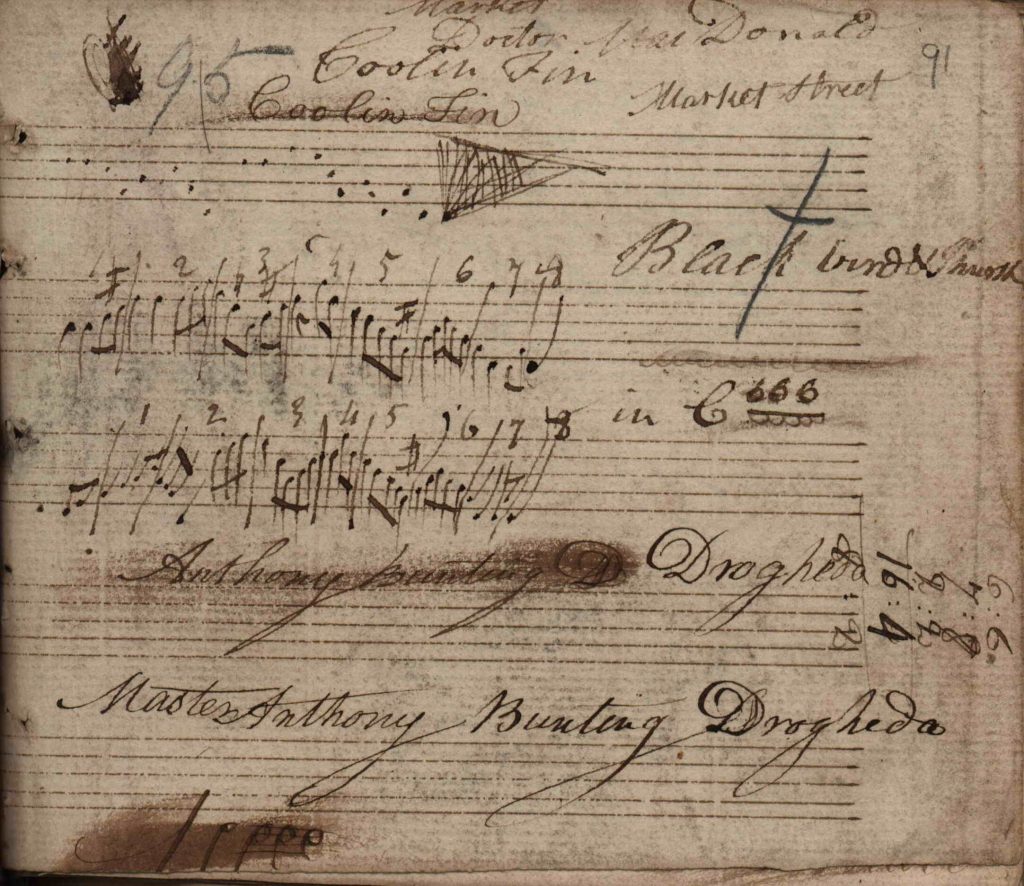
This first machine audio plays through the manuscript notations but ignores all of the little accidental markings. You can hear that the tune is in a kind of D minor mode. We expect D minor pentatonic mode to have prominent D, F, G, A, C, and this tune does, though it also has quite strong E and B. The strong B natural especially is quite intrusive. Perhaps we could think of the tune as being D neutral, which would have the main notes as D, E, G, A, C, D. I suppose one way to decide is which you think of E or the F as the “main note” and the “out of mode note”. It may be possible to “push” it in different directions using phrasings or fingerings, to emphasise certain notes and rush over others; the transcription notation does not necessarily show this aspect of traditional style.
So, what about those accidentals? I think there are a few problems with reading them. There is the question of whether we should think of an implied B♭ (as would be suggested by the transposition down one note to give a key signature of 3 flats). And then if so, whether the sharp sign in bars 1 and 3 should be understood to apply to both the B and the C, giving the rising sequence A – B natural – C sharp. This would match the later piano arrangements. And I note that the other accidentals are written above the note they apply to, so the two sharp signs written above the Bs in bars 1 and 3 ought then to apply to those Bs.
Here’s a machine audio of the transcription notation incorporating the implied key signature of one flat, and the accidentals with the sharps in bars 1 and 3 taken as applying to both the B and the C in each bar:
The instruction “in C♭♭♭” is also interesting, and we often talk here about those of Bunting’s transcriptions which are notated one note higher than a plausible harp key. However, C minor with three flats is not at all a plausible harp key. D minor with one flat is also not a plausible harp key. Maybe this is a vocal transcription and nothing to do with the harp.
My conclusion here is that I don’t believe the accidentals are part of the traditional performance version; but I do not know if Bunting’s informant played or sang this in D minor all naturals, or sang it in D minor one flat, or in C minor 3 flats. I think there is an interesting sound to playing this on the harp in D minor with the harp tuned all naturals.
Piano arrangements
Edward Bunting continued his process of de-traditionalising this tune, to bring it into his own classical music world on the piano.
Bunting’s earliest piano arrangement is in his unpublished “Ancient and Modern” keyboard collection, apparently compiled in 1798, which is now QUB SC MS4.33.3&2.
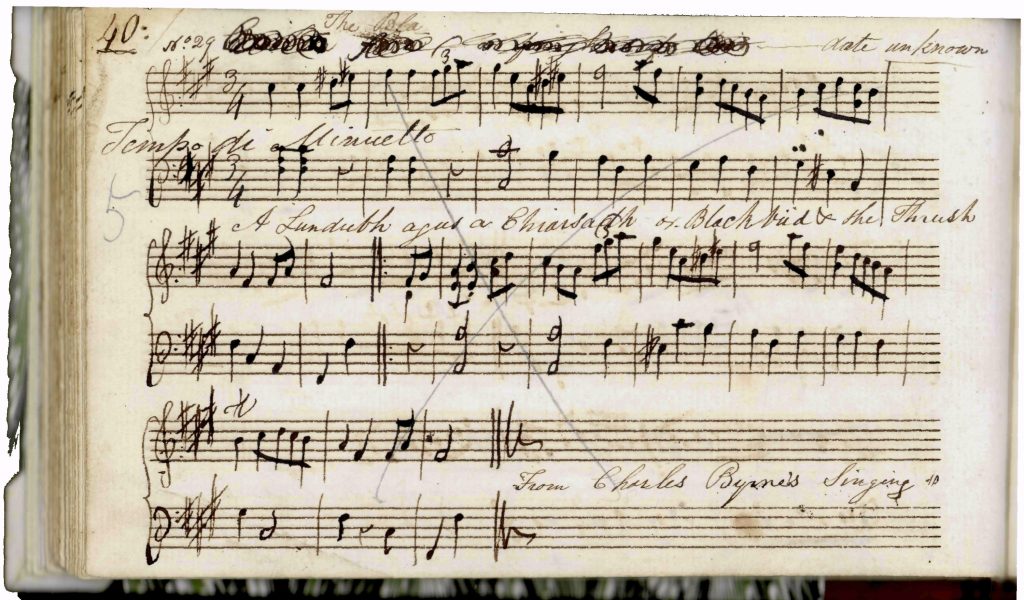
Normally I don’t like to listen to Bunting’s piano arrangements, because they give us his classical re-imagining of the tunes. But this should be useful to help us make sense of the accidentals on the transcription. You can see that he has transposed the tune to F sharp minor, with three sharps in the key signature, and he has also added accidentals for the rising passages c♯-d♯-e♯-f♯ (which correspond to the notes a-b-c(♯)-d in the transcription). But in bar 5 of each half, he doesn’t sharpen the bottom of the turn d♯-c♯-b-a-b (corresponding to b-a-g-f(♯)-g in the transcription manuscript. I think that his choices in where to place these accidentals is driven by his classical chord progression rules and style, and he is adjusting the tune to fit in with classical minor norms and expectations on the piano.
The text on this page is very interesting. At the top of page 40, Bunting has written a different title – I can’t make it out under his scribbling. It may possibly be the title from page 38, “Castle Moon, or soft Board of Deal” but I am not entirely convinced. The also writes “date unknown” but it is not clear if this refers to the deleted title or to our tune. In any case I think he was rather grandiosely making up these “date” tags in many cases. Above the scribbled out title he starts to write “The Bla” and then he changes his mind and writes the full title above the second system: “A Lundubh agus a Chiarsadh or Blackbird & the Thrush”. And finally, at the bottom of the page he writes “From Charles Byrne’s Singing” and then two tiny letters. Are they “AB”? Is Edward somehow tagging his brother Anthony? Did Anthony do some of the collecting and transcription notations? We have a reference to Edward planning to go out collecting with his brother John.
Our tune next appears in piano arrangements at the end of the 1830s, as Bunting was preparing for publication of his final book. There are two very similar piano albums which I think were written out by editors as part of the pre-publication process. They are not in Edward Bunting’s handwriting I don’t think. Our tune appears as basically the exact same piano arrangement in both of these manuscript books.
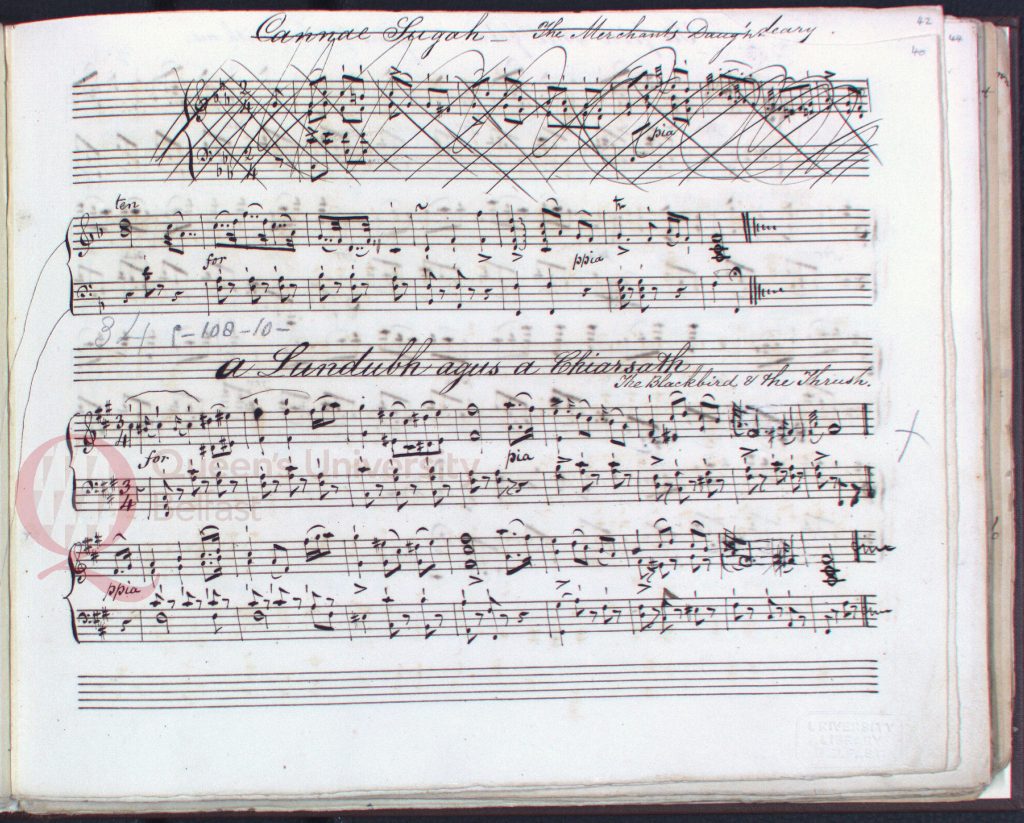
The title here is “a Lundubh agus a Chiarsath / The Blackbird & the Thrush”. You can see and hear that we are right into 1830s piano world.
Here’s the other one:
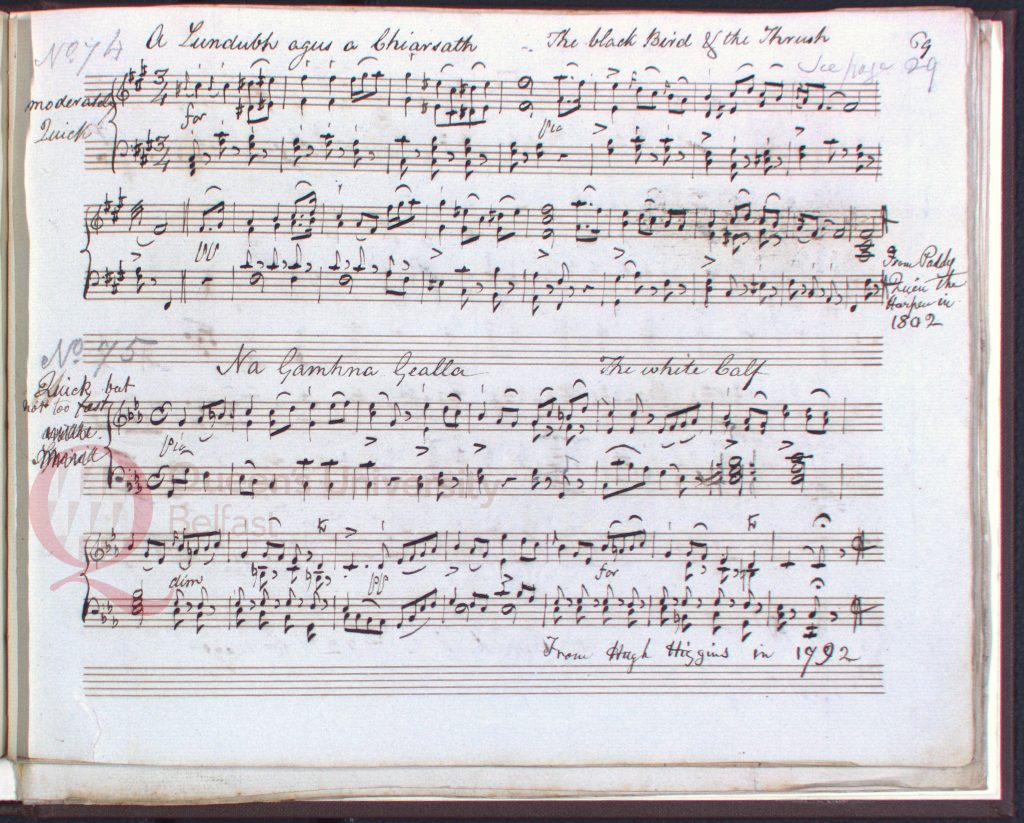
The title here is “A Lundubh agus a chiarsath – the black Bird & the Thrush”. You can see that this is almost exactly the same – the line ending is ever so slightly simpler, with one repeated note and its gracenote omitted. I have not made a machine audio for you of this one.
In QUB SC MS4.13 there is no attribution tag, but in QUB SC MS4.27 it says “from Paddy Quin the Harper in 1802”. There is also the pencil note “see page 29” which takes us to a piano arrangement of a different tune “Cearc agus coileach” (see below)
Bunting finally published his piano arrangement as tune no.3 on page 3 of his 1840 book. His title there is “The blackbird and the thrush” and it is basically the same piano arrangement as in ms4.13 and ms4.27. For the attribution on the index page x, he says he collected it “at Ballinrobe, county Mayo, 1792”. On the index page i, he gives an Irish title “An lon dubh agus án smolach”. I think both the attribution and title are made up or wrong – more below.
Other “Blackbird” tunes & songs
Bunting has two other blackbird tunes, which he also published in 1840. Neither of these is related to our tune, but I think he got the titles and attributions mixed up a bit. On 1840 no.7 p.5 is “the blackbird and the hen” which Bunting gives the Irish title “An londubh agus an cheirseach” (index p.ii), and attributes it “at Ballinrobe 1792”. I think both these titles are probably wrong, but I think this attribution is correct. We can recognise this piano arrangement as deriving from a transcription notation in part four of ms29, which contains tunes Bunting collected from singers when he was in Connacht with Kirwan in summer 1792. The tune is written as a dots transcription and a neat copy on the top half of QUB SC MS4.29 page 237 under what is probably the correct title, “Chark agus Challagh / Cock & the Hen”.
We should also note a variant of this same tune is 1840 no.76 p.55 “Sweet Portaferry” which is attributed “J McCracken Esq, Belfast, 1800”
The other tune, on 1840 no.98 p.72 “The Blackbird”, is given an Irish title (index p.ii) “An londubh” and attributed (index p.x) “D. O’Donnell, harper, County Mayo, 1803”. This is a variant of the well known set dance and I haven’t found a transcription version of it in Bunting’s papers.
I don’t think either of these tunes is relevant but they can help us to untangle Bunting’s confusing mix-up of titles and attributions.
There is also a song which is sung today in the tradition under the title An Londubh is an Chéirseach. Here’s a superb recording of Eibhlís Tóibín from County Waterford singing it; you can also hear it being sung by Seamus Begley on Youtube, or you can listen to an interesting recording of Lisa Butler from Carlow which also gives the full text and English translation. The tune is very different to our tune; I don’t know how old the tune is. You can hear the tune being played as a slow air by Tomás Ó Canainn and his band.
Patrick Lynch collected the words of this song out in Mayo in June 1802. In his Journal (QUB SC MS4. 24 page 51), he lists a song lyric with the title “A Lundubh sa Chearsach” as having been collected “at John Gavans” the early summer of 1802. QUB SC ms4.7 p138 has the text, titled “Londubh sa chearsach / a very pretty song”. The first of Lynch’s three verses is:
Tán londubh sa chéarsach san uiseoigin le cheile
sa smóilin bhinn bréagach na deigh ansa siód
a chuach a measg an méad sin ag sinim dán is bheasa
do chul trom tais na bpearla is dom ched mhile grádh
Lynch has inserted alternative readings for some words which is unusual in his neat presentation books.
Colette Moloney’s introduction and catalogue (2000) p.274 lists another Lynch copy of the song in QUB SC MS4.16, but I haven’t seen this manuscript. Moloney lists this song as being tagged at the top “From Mrs Gavan” and at the bottom “from Redmond Stanton”.
As usual, we have no idea what tune was used by Lynch’s informant(s). And the only connection to our tune is the title or theme of the song. There are of course many other different tunes and songs in the tradition with the title “blackbird”. But I have not found one with a connection to our tune.
Titles
Our manuscript transcription page is clearly titled “Black bird & Thrush” which gives us a solid start. A few years later, in the 1798 piano manuscript, Bunting also gives us an Irish title, which we can normalise as “londubh agus an chéirseach”, i.e. the blackbird and the hen blackbird. However after that it all goes a bit flakey.
In his 1840 book, Bunting changes “céirseach” (which means a hen blackbird) to “smólach”, which means a thrush. This all makes me suspect the Irish titles in 1840 might be back-translations from the English.
The title of the blackbird and the thrush references folk beliefs or folk etymologies, or myths, where the (male) blackbird marries or mates with the (female) thrush; or that “thrush” is a name for the lady blackbird; or something similar. Song thrushes and female blackbirds can look very similar. Bunting must have had some inkling about all this, because for the completely separate tune “Cearc agus coileach” which translates as “cock and hen”, he drops that title in 1840 and uses our title “londubh agus an chéirseach” instead, with the perhaps more literal English version “blackbird and hen”.
A curve ball is that O’Neill published Bunting’s piano melody in 1903, as no. 225 “Cait og Ua Cill-Chomain / Young Kate of Kilcummer”. Perhaps this is an alternative song lyric for the tune, or perhaps it is just completely wrong.
Donal O’Sullivan in his Bunting (1983) p.5 gives a title “An londubh agus an ciarseach”. But I don’t know where he has got the word “ciarseach” from – it appears to be a slight adjustment of Bunting’s dubious “chiarseagh” and it doesn’t appear in the standard dictionaries. He doesn’t handle this tune very well to be honest, printing it in D minor with one flat, and with an unrelated English-language text which was sung “to a different tune”, because he says there are no words in Bunting’s manuscripts.
Attributions to harpers and other informants
Seeing how Bunting has got muddled with the titles between 1840 no.3 (our tune) and 1840 no.7 (the Cock and the Hen), it is no surprise to see him also getting muddled with the attributions. I think that, just as he transferred the “londubh agus céirseach” title over from our tune onto no.7, so he has also transferred the “Ballinrobe 1792” attribution over from no.7 (where it seems genuine) onto our tune (where it doesn’t).
So if we disregard the Ballinrobe 1792 origin for our tune, we are left with two different piano arrangement tags; on one of the 1830s piano arrangements it is attributed to Patrick Quin, and in the 1798 piano arrangement it is attributed to Charles Byrne singing. I am generally a bit dubious of the attributions from the 1830s and 1840s, since they were done about 40 years after Bunting was making the live transcriptions; we know his record keeping and organising of his papers was a bit messy; we can see that so many of his later attributions are dodgy, and they often clash with the early attributions. I mean, it is quite possible that Quin did play this tune, but I think it unlikely that the transcription we are looking at on MS4.29 page 95 was written live from Quin’s playing. At best I would think that the Quin tag is just telling us that Quin played a version of this tune (which we don’t have); at worst we might suspect that the Quin attribution may have been invented antiquarian decoration to make the (classical and very up to date) piano arrangement look a bit more “ancient” and “Irish”.
We can recognise the accidentals on the rising and falling sections as being very much a classical minor thing that is the kind of change that Bunting would have made, but I also wonder if Byrne was singing for Bunting when he was making the transcription, might this partly explain the strange key or mode and accidentals? We are told that Byrne was not a good harper, self-taught according to William Carr, and “worse than tol lol” according to Arthur O’Neill. Did his vocal intonation waver enough to suggest to Bunting the accidentals? Did he pitch things at non-harp-friendly pitch levels, such as singing this song in C minor?
There is one other quite strong possibility for our p.95 transcription, and that is that it may have been done as a live transcription from singer and harper, Daniel Black, at Glenoaks, near Crumlin, in summer 1796. If we check on my Old Irish Harp Transcription Project Tune List spreadsheet, we can see that there is a tune list in QUB SC MS4.29 p.178, with a list of tune titles each attributed to Daniel Black, including “Black bird & thrush”. Of the 8 tunes in this list on p.178, there are live transcriptions of five of them on pages 93 through to 96 of MS4.29, including “Black bird & thrush”. We have the description of Black, who sung and “…played chords in the Arpeggio style with excellent effect” (1840 intro p.97). Could we imagine Black playing a D bass drone chord (perhaps bass A-D-D using taobhchrobh fingering?) as he sung the song in D minor, singing the flat (or variable) B?
Is this the reason Bunting wrote the title on p.95 “Black bird&Thrush”, with “Black” separate and slightly bigger?
Thanks to Sylvia Crawford for pointers on sources and collations.
Many thanks to Queen’s University Belfast Special Collections for the digitised pages from MS4 (the Bunting Collection), and for letting me use them here.
Many thanks to the Arts Council of Northern Ireland for helping to provide the equipment used for these posts, and also for supporting the writing of these blog posts.
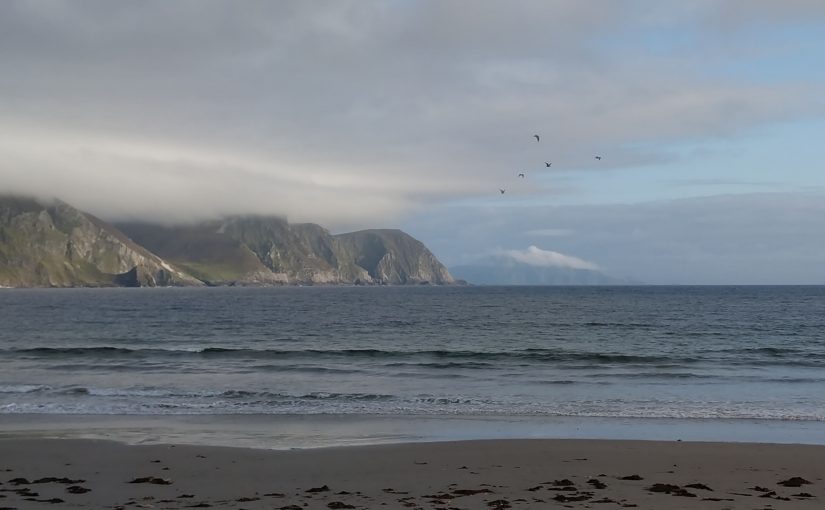

One thought on “An londubh agus an chéirseach”